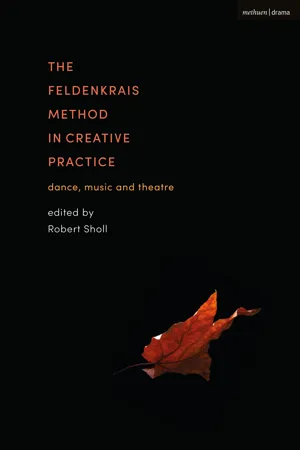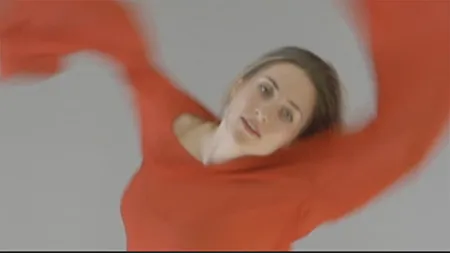![]()
PART I
HISTORICAL PERSPECTIVES ON CREATIVE PRACTICE
![]()
CHAPTER 1
DANCING THE SOMA-ECSTATIC: FELDENKRAIS AND THE MODERNIST BODY
Thomas Kampe
Introduction
This chapter retraces body codes and emancipatory ethics found in the work of Moshe Feldenkrais (1904–84) to the beginnings of early Modernist European Dance and Body Cultures. The author suggests that Feldenkrais’s emphasis on fostering the mature adult as a creative and emancipated individual emerged from the early Modernist ‘Körperkultur’ (body culture) and dance beginnings that formed important part of the cultural milieu in 1920s Palestine. Feldenkrais experienced holistic dance/gymnastic studies with Israeli expressive modern dance pioneer Margalit Ornstein (Vienna 1888–Tel Aviv 1973) before moving to Paris. Ornstein was influenced by the work of Viennese choreographer Gertrud Bodenwieser (1890–1959) and European body-culture pioneer Bess Mensendieck (1864–1957), both visionary emancipatory proto-somatic pioneers. While revealing similarities between Mensendieck’s, Bodenwieser’s and Feldenkrais’s ethos and practices, the chapter also places Feldenkrais into the context of post-1940s Israeli body culture which drew on European Modern Dance and holistic Reform-Gymnastic practices including the work of Elsa Gindler (1885–1961). By offering an alternative and feminist history, this chapter reviews the beginnings of Feldenkrais’s work not as the work of a monolithic genius but as situated within an interdisciplinary milieu that emerged from utopian and diasporic Modernist artistic and educational endeavours.
Dancing the soma-ecstatic
This chapter argues that the emancipatory dimensions within Feldenkrais’s work emerge through his own first-hand encounters and experiences with proponents and practices of reform-gymnastics and education, and through his contact with European Modern dance practitioners who understood dance as an increasingly important ‘factor in education’.1 This Western Modernist Body Culture and Dance milieu ‘explored new kinds of thinking about the bodily experience’, where movement is understood as vessel for personal, artistic and social activation and transformation.2
Rothe proposes that beyond methods of training developed by men such as Rudolf Laban, Rudolf Bode or Jacques-Dalcroze, it was mainly women practitioners of the Lebensreform – Life reform movement – who ‘intended to draw together psychological feeling, bodily experience dance and musical elements, into an all embracing, free and creative way of life. This plan revolved about the body’.3
Such practices of reform-gymnastics became part of an emancipatory educational Zeitgeist and milieu that privileged self-directed development against heteronomous learning. As Weaver concludes:
Reform-gymnastics proposed a different approach where the voice of the teacher and external bio-mechanical reasoning was replaced by developing an awareness of the student’s inner rhythms and of the requirements of his organism.4
There appear to be immediate affinities between the European Modern dance heritage that asked for a ‘thinking in terms of movement as contrasted with thinking in words’ and the embodied ‘thinking without words, with images, patterns and connections’ leading ‘to a new way of action’ which Feldenkrais proposes.5 Both aim to blend analysis with experience, action with reflection, exploration with discovery, and heightened self-awareness with a capacity for self-directed interaction with the environment.6
The synergies between the Feldenkrais Method and psycho-physical movement approaches developed within the twentieth-century theatre and dance cultures are rarely discussed in literature by Moshe Feldenkrais, nor in his recently published biographies or works that analyse his cultural milieu.7
It therefore seems surprising that in the edited conversation of 1965 between Moshe Feldenkrais and theatre director Richard Schechner, Feldenkrais reveals detailed insights into the training approaches developed by Russian theatre practitioner Konstantin Stanislavski (1863–1938).8 Stanislavski’s later approach to acting which highlighted embodiment and action is akin to Feldenkrais’s own rationale for privileging movement as an accessible educational lever to access an awareness the unity of ‘whole self’.9 Feldenkrais sets out that his approach is ‘mainly concerned with learning a better mode of action and uses of the body, from which the person can learn directly, in his own body language’.10 This ability to learn directly from uses of the body is equally articulated in early-twentieth-century writings by Stanislavski whose work was concerned with the ‘organismic functioning of man’, where thinking and feeling are necessarily an embodied whole.11
Like Feldenkrais (in his book Awareness through Movement), he was concerned with accessing the person’s agency, creativity and potential through movement. ‘We are more at home with physical action than with the elusive nature of emotion. Here we can find our bearing better, here we are more inventive, and more certain than with subjective elements which are difficult to capture and fix.’12 Stanislavski’s system of Spiritual Realism was inspired by his personal encounter with Modern Dance pioneer Isadora Duncan (1877–1927) in Moscow in 1907. Modern Dance, as an emerging twentieth-century genre concerned with embodied forms of human expression through dynamic action, seemed to provide ‘an imaginative richness in material and a search for truth’, at the heart of Stanislavski’s psycho-physical training system and rehearsal practice.13
Between 2014 and 2019 I collaborated on the research project Releasing the Archive with choreographer and dance scholar Carol Brown and dancers of The New Zealand Dance Company. The research intended to re-embody Modernist Dance practices formulated by Viennese choreographer Gertrud Bodenwieser through accessing choreographic and training practices transmitted through members of the original Viennese companies, archival notes, books, photographs and writings by Bodenwieser. Bodenwieser was the first Professor for Dance and Choreography at the Viennese Staatsakademie, and resigned shortly before the Nazis took over governance in March 1938. As a displaced Jewish dance-maker she spent twenty years in exile in Australia where she and her disciples laid foundations for Modern Dance development.
Our initial research was concerned with re-animating body codes embedded in Bodenwieser’s work through Feldenkrais-informed preparatory and interventional processes. These included the use of Awareness through Movement (ATM) lessons, touch interaction, and reflective non-corrective trial and error modalities as part of the choreographic experiments with the dancers.
The dialogue between the introspective, somatic Feldenkrais processes and the ecstatic Modern dance ‘body-based testimonies’ explored seemed surprisingly fluid and empowering for dancers involved.14 Dancer Katie Rudd reflects on a change in agency, body image and three-dimensional use of body shaping in her dancing:
I am learning to be more open and lengthened spatially, and that there are more sides/fronts to my body, not just the mirror. A lot of contraction and openings. Movement at is extreme. Wide and spatial.15
Figure 1.1 Dancer Katie Rudd in project ‘Releasing the Archive’ (2016).
Dancer Lucy Lynch describes a shift in capacity for core-initiation from torso and pelvis in her dancing as an organically liberating resource for greater variation in movement choices, as a result of engaging with a soma-ecstatic Feldenkrais/Bodenwieser dialogue:
I felt an obvious change and difference in my body and also how both techniques informed my way of moving. […] I found both techniques can lead me to discover more possibilities of how I move around my pelvis and how I include my back movement into my way of moving. It gives me so much more freedom of how I could use my body and how I create movements in many different ways, instead of just focusing on the movement of my limbs.16
Bodenwieser was a leading proponent of Ausdruckstanz (dance of expression) which she described as The New Dance which ‘does not content itself with being enchanting and entertaining only; it wishes to be stirring, exciting and thought-provoking’.17
Such ‘stirring, exciting, and thought-provoking’ dance practice might be easily reframed as de-familiarizing, un-conditioning, stimulating and reflective processes that challenge the participants’ habitual self-image and ways of world-making, similar to working modalities at the heart of the Feldenkrais Method.
Bodenwieser’s choreographic work requires a systematically trained dancer-body that, in similar ways to the body-coding Feldenkrais prescribes is poly-centric and omni-directional in coordination. She understood Modernist dance and body cultures as being part of a ‘great revolution of freeing the human mind’ and placed great attention to the training of a liberated, emotionally expressive dancer.18
Drawing on the reform practices of François Delsarte (1811–71) and Bess Mensendieck (1864–1957), Bodenwieser sought to develop an education which activates the mover to sense, initiate and organize movements from their core. She describes this as ‘the torso being given the melody of the composition, while the lower parts of the body carry the structure, the bass of the symphony’.19
Such body-coding lends itself easily to preparatory practices developed through the application of Feldenkrais lessons. While the Feldenkrais Method aims to foster the development of greater self-awareness in the mover, lessons are designed to improve an organic functioning through providing a focus on smooth control of changes in gravity response, spatial orientation and initiation in different body areas. Numerous Awareness through Movement ATM lessons aim to mobilize the mover’s pelvis in rocking or see-saw movements, enable successive flow through the spine, or activate the dynamic and rotary relationships between the mover’s torso and limbs.
The research project revealed several affinities between preferred body-codings within the work of Gertrud Bodenwieser and Feldenkrais’s organic movement practices. At times, simply enlarging patterns explored in a Feldenkrais lesson led directly to a Bodenwieser movement vocabulary, such as large back arching waves through the spine, or a spiralling use of the limbs in figure of ...

